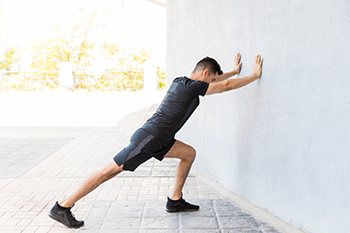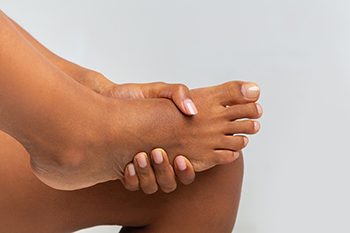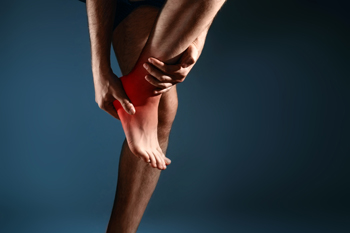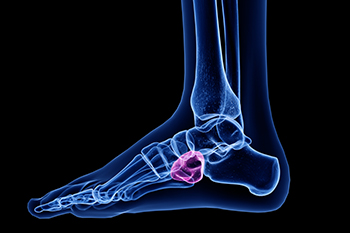Items filtered by date: September 2025
An Easy Stretch for Feet and Ankles

If you are an athlete, then you are likely aware of the many foot and ankle injuries one might face while participating in sports. The feet and ankles are the foundations of the body, but they undergo a lot of wear and tear during most physical activity. Because of this, it is important to stretch your feet and ankles, giving them the strength and flexibility that they need to work out. One easy stretch that you can do is standing in front of a wall and placing the toes of one foot on that wall while keeping your heel on the floor. Flex the foot and hold for 10 to 15 seconds. You should feel a stretch in your foot and calf. For more information about stretches for your foot and ankle health, it is suggested that you consult with a podiatrist today.
Stretching the feet is a great way to prevent injuries. If you have any concerns with your feet consult with one of our podiatrists from New York, NY. Our doctors will assess your condition and provide you with quality foot and ankle treatment.
Stretching the Feet
Being the backbone of the body, the feet carry your entire weight and can easily become overexerted, causing cramps and pain. As with any body part, stretching your feet can serve many benefits. From increasing flexibility to even providing some pain relief, be sure to give your feet a stretch from time to time. This is especially important for athletes or anyone performing aerobic exercises, but anyone experiencing foot pain or is on their feet constantly should also engage in this practice.
Great ways to stretch your feet:
- Crossing one leg over the others and carefully pull your toes back. Do 10-20 repetitions and repeat the process for each foot
- Face a wall with your arms out and hands flat against the wall. Step back with one foot and keep it flat on the floor while moving the other leg forward. Lean towards the wall until you feel a stretch. Hold for 30 seconds and perform 10 repetitions for each foot
- Be sure not to overextend or push your limbs too hard or you could risk pulling or straining your muscle
Individuals who tend to their feet by regular stretching every day should be able to minimize foot pain and prevent new problems from arising.
If you have any questions please contact our office located in New York, NY . We offer the newest diagnostic and treatment technologies for all your foot and ankle needs.
Preventing Workplace Falls

Falling in the workplace can result in serious foot injuries that can lead to long-term pain and mobility issues. When a person falls, the feet are often the first point of contact, which can cause sprains, fractures, or even damage to the soft tissues. The impact from a fall may also lead to bruising or swelling, making it difficult to walk or stand. To prevent such injuries, it is important to maintain a clean and clutter-free work environment, ensuring that floors are free from hazards, such as wet spots, cords, or obstacles. Proper footwear with adequate support and slip-resistant soles helps to reduce the risk of falls. Sustaining a foot or ankle injury from falling during the workday may result in a loss of wages due to time off. If this has happened to you, it is suggested that you consult a podiatrist who can treat this type of condition and offer effective fall prevention techniques.
Preventing falls among the elderly is very important. If you are older and have fallen or fear that you are prone to falling, consult with one of our podiatrists from New York, NY. Our doctors will assess your condition and provide you with quality advice and care.
Every 11 seconds, an elderly American is being treated in an emergency room for a fall related injury. Falls are the leading cause of head and hip injuries for those 65 and older. Due to decreases in strength, balance, senses, and lack of awareness, elderly persons are very susceptible to falling. Thankfully, there are a number of things older persons can do to prevent falls.
How to Prevent Falls
Some effective methods that older persons can do to prevent falls include:
- Enrolling in strength and balance exercise program to increase balance and strength
- Periodically having your sight and hearing checked
- Discuss any medications you have with a doctor to see if it increases the risk of falling
- Clearing the house of falling hazards and installing devices like grab bars and railings
- Utilizing a walker or cane
- Wearing shoes that provide good support and cushioning
- Talking to family members about falling and increasing awareness
Falling can be a traumatic and embarrassing experience for elderly persons; this can make them less willing to leave the house, and less willing to talk to someone about their fears of falling. Doing such things, however, will increase the likelihood of tripping or losing one’s balance. Knowing the causes of falling and how to prevent them is the best way to mitigate the risk of serious injury.
If you have any questions, please feel free to contact our office located in New York, NY . We offer the newest diagnostic and treatment technologies for all your foot care needs.
Symptoms and Causes of Foot Tendonitis

Symptoms of tendonitis in the foot often begin with sharp, burning, or aching pain along the affected tendon, especially during movement. Swelling can develop over time, sometimes forming into a tender lump along the tendon. Stiffness in the foot or ankle may limit motion and make walking, climbing stairs, or standing on tiptoes uncomfortable. Discomfort is usually worse with activity and may temporarily ease with rest, only to return when weight is placed back on the foot. Causes of tendonitis in the foot include repetitive strain from activities that overwork the tendons, direct injuries such as an ankle sprain, or friction from shoes that rub against the tendon. Abnormal foot structure, like flat feet or high arches, can also place uneven stress on tendons, increasing the risk of inflammation. A podiatrist can identify which tendon is affected, provide guidance on proper support, and recommend treatment that may include surgery, if necessary. If you are experiencing symptoms of tendonitis in the feet, it is suggested that you schedule an appointment with a podiatrist for an evaluation and appropriate treatment.
Foot Pain
Foot pain can be extremely painful and debilitating. If you have a foot pain, consult with one of our podiatrists from New York, NY. Our doctors will assess your condition and provide you with quality foot and ankle treatment.
Causes
Foot pain is a very broad condition that could be caused by one or more ailments. The most common include:
- Bunions
- Hammertoes
- Plantar Fasciitis
- Bone Spurs
- Corns
- Tarsal Tunnel Syndrome
- Ingrown Toenails
- Arthritis (such as Gout, Rheumatoid, and Osteoarthritis)
- Flat Feet
- Injury (from stress fractures, broken toe, foot, ankle, Achilles tendon ruptures, and sprains)
- And more
Diagnosis
To figure out the cause of foot pain, podiatrists utilize several different methods. This can range from simple visual inspections and sensation tests to X-rays and MRI scans. Prior medical history, family medical history, and any recent physical traumatic events will all be taken into consideration for a proper diagnosis.
Treatment
Treatment depends upon the cause of the foot pain. Whether it is resting, staying off the foot, or having surgery; podiatrists have a number of treatment options available for foot pain.
If you have any questions, please feel free to contact our office located in New York, NY . We offer the newest diagnostic and treatment technologies for all your foot care needs.
Reasons You Might Have Heel Pain

Heel pain can interfere with daily activity and mobility. In many cases, heel pain develops from overuse, repetitive stress, or wearing footwear that lacks adequate support. Running on hard surfaces, sudden increases in activity, or tightness in the calf muscles and Achilles tendon can also contribute to this type of pain. Injuries, such as a heel bone fracture from a fall or hard landing, may also be factors. Conditions including plantar fasciitis, bursitis, Achilles tendon inflammation, or the growth of bone spurs can further lead to tenderness, stiffness, and swelling at the heel. Pain may be felt under the heel, at the back of the heel, or along the Achilles tendon, depending on the underlying cause. A podiatrist can provide a full evaluation, offer proper treatment, and determine whether imaging or surgery may be needed. If you are experiencing heel pain, it is suggested that you schedule an appointment with a podiatrist for a diagnosis and appropriate treatment.
Many people suffer from bouts of heel pain. For more information, contact one of our podiatrists of New York, NY. Our doctors can provide the care you need to keep you pain-free and on your feet.
Causes of Heel Pain
Heel pain is often associated with plantar fasciitis. The plantar fascia is a band of tissues that extends along the bottom of the foot. A rip or tear in this ligament can cause inflammation of the tissue.
Achilles tendonitis is another cause of heel pain. Inflammation of the Achilles tendon will cause pain from fractures and muscle tearing. Lack of flexibility is also another symptom.
Heel spurs are another cause of pain. When the tissues of the plantar fascia undergo a great deal of stress, it can lead to ligament separation from the heel bone, causing heel spurs.
Why Might Heel Pain Occur?
- Wearing ill-fitting shoes
- Wearing non-supportive shoes
- Weight change
- Excessive running
Treatments
Heel pain should be treated as soon as possible for immediate results. Keeping your feet in a stress-free environment will help. If you suffer from Achilles tendonitis or plantar fasciitis, applying ice will reduce the swelling. Stretching before an exercise like running will help the muscles. Using all these tips will help make heel pain a condition of the past.
If you have any questions, please feel free to contact our office located in New York, NY . We offer the newest diagnostic and treatment technologies for all your foot care needs.
Gout Pain Can Be Managed
Cuboid Syndrome and Lateral Foot Pain

Cuboid syndrome is a condition where the cuboid bone, located on the outer side of the midfoot, becomes partially dislocated or restricted in movement, leading to lateral foot pain. It is often caused by ankle sprains, repetitive stress, or overuse in athletes and active individuals. Symptoms include sharp pain along the outer foot, swelling, tenderness, and difficulty walking or bearing weight. Risk factors include wearing shoes that lack adequate support, high impact activities, or biomechanical issues, such as flat feet. A podiatrist can diagnose cuboid syndrome, provide manual manipulation, prescribe orthotics, and recommend exercises to restore alignment and relieve pain. If you are struggling with outer foot discomfort, it is suggested that you consult a podiatrist who can accurately diagnose and treat cuboid syndrome.
Cuboid syndrome, also known as cuboid subluxation, occurs when the joints and ligaments near the cuboid bone in the foot become torn. If you have cuboid syndrome, consult with one of our podiatrists from New York, NY. Our doctors will assess your condition and provide you with quality foot and ankle treatment.
Cuboid syndrome is a common cause of lateral foot pain, which is pain on the outside of the foot. The condition may happen suddenly due to an ankle sprain, or it may develop slowly overtime from repetitive tension through the bone and surrounding structures.
Causes
The most common causes of cuboid syndrome include:
- Injury – The most common cause of this ailment is an ankle sprain.
- Repetitive Strain – Tension placed through the peroneus longus muscle from repetitive activities such as jumping and running may cause excessive traction on the bone causing it to sublux.
- Altered Foot Biomechanics – Most people suffering from cuboid subluxation have flat feet.
Symptoms
A common symptom of cuboid syndrome is pain along the outside of the foot which can be felt in the ankle and toes. This pain may create walking difficulties and may cause those with the condition to walk with a limp.
Diagnosis
Diagnosis of cuboid syndrome is often difficult, and it is often misdiagnosed. X-rays, MRIs and CT scans often fail to properly show the cuboid subluxation. Although there isn’t a specific test used to diagnose cuboid syndrome, your podiatrist will usually check if pain is felt while pressing firmly on the cuboid bone of your foot.
Treatment
Just as the range of causes varies widely, so do treatments. Some more common treatments are ice therapy, rest, exercise, taping, and orthotics.
If you have any questions, please feel free to contact our office located in New York, NY . We offer the newest diagnostic and treatment technologies for all your foot care needs.


